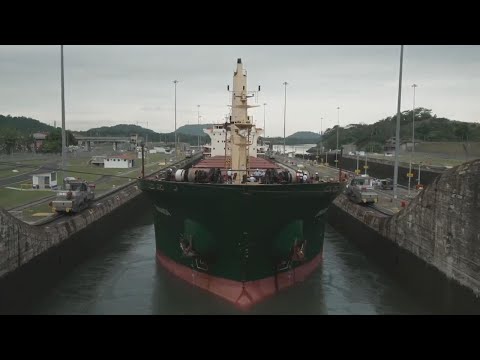(13 Jun 2024)
RESTRICTION SUMMARY:
ASSOCIATED PRESS
ARCHIVE: Panama City, Panama – 5 May 2024
++MUTE++
1. Aerial of Panama Canal and port
ASSOCIATED PRESS
ARCHIVE: Panama City, Panama – 8 May 2024
2. Various of ship before crossing the canal
3. Sign reading (English) "Miraflores Locks – Panama Canal"
ASSOCIATED PRESS
Panama City, Panama – 12 June 2024
4. SOUNDBITE (Spanish) Ayax Murillo, head hydrologist at the Panama Canal:
"Between the end of the Panama Canal’s fiscal year, end of September, and the beginning of the next one in October, we should be close to 36 daily (ship) crossings, as long as the maritime industry reacts accordingly."
ASSOCIATED PRESS
ARCHIVE: Panama City, Panama – 8 May 2024
5. Various of lock gates opening
6. Various of vehicles, known as "mules", pulling ship through canal
ASSOCIATED PRESS
Panama City, Panama – 12 June 2024
7. SOUNDBITE (Spanish) Ayax Murillo, head hydrologist at the Panama Canal:
"These hydro-meteorological projections of all parameters (showing water levels will likely increase) have allowed the Panama Canal to gradually increase the number of (ship) crossings."
ASSOCIATED PRESS
ARCHIVE: Panama City, Panama – 3 May 2024
8. Panama Canal locks and bridge in background
9. New, bigger NeoPanamax locks
ASSOCIATED PRESS
ARCHIVE: Panama City, Panama – 8 May 2024
10. Ship crossing Panama Canal
11. Lock gate closing behind ship
12. Timelapse of ship being lifted on locks ++MUTE++
13. Close of ship sailing canal after crossing Miraflores Locks
14. Flag of Panama
ASSOCIATED PRESS
ARCHIVE: Panama City, Panama – 4 May 2024
++MUTE++
15. Aerial of ship waiting to cross Panama Canal on the Pacific Ocean side
STORYLINE:
The Panama Canal expects to resume normal traffic levels by October after restricting the number of ships crossing daily due to months of severe drought.
All restrictions should be lifted "between the end of the Panama Canal’s fiscal year, end of September, and the beginning of the next one in October," the canal’s head hydrologist, Ayax Murillo, told The Associated Press on Wednesday.
The Panama Canal Authority recently announced it will increase the maximum number of ships traveling the waterway to 34 per day in July, two more than now, after the rainy season begins in May.
But, the new number is still lower than the daily average of 36 to 38 ships per day under normal operation.
A drought that began last year has reduced the supply of fresh water needed to operate locks that act as "water stairs" helping boats to climb hills between the Pacific Ocean and the Caribbean Sea.
In turn, the canal implemented a measure capping the number of ships passing through its locks daily to as low as 22 ships per day at the end of 2023, when the crisis was at its worst.
Now, enough rain is expected to fall to slowly feed the watershed system of rivers and brooks that fill lakes, whose waters fill the locks, Murillo said.
The watershed also supplies fresh water to Panama City, home to about half the country’s four million people.
Authorities have blamed the lack of water on the El Nino weather phenomenon, which contributes to higher global temperatures, and climate change.
José Raúl Mulino, who will take office on July 1 as the country’s next president, recently said he would urge lawmakers to approve a law enabling the construction of large water reservoirs.
Roughly 5% of the world’s seaborne trade and 40% of all U.S. container traffic passes through the canal yearly.
The United States is its main customer, followed by China, Japan, South Korea, and Chile.
Find out more about AP Archive: http://www.aparchive.com/HowWeWork
Twitter: https://twitter.com/AP_Archive
Facebook: https://www.facebook.com/APArchives
Instagram: https://www.instagram.com/APNews/
You can license this story through AP Archive: http://www.aparchive.com/metadata/youtube/81d6d9e603714381966f68bec71fed40





